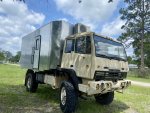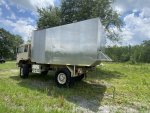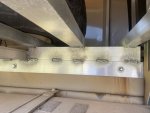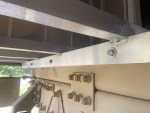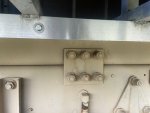With my paramedic background, I originally wanted to build out an old ambulance as a camper. The idea of external locking storage and so on was alluring. Then I started pricing 4x4 models with the specs I wanted (I live in Alaska so it’s a must), and it stopped making financial sense. Fast forward a couple months and I found myself perusing the marketplace and stumbled on something that piqued my interest. It’s a 1997 M1078A0 with a custom aluminum habitat mostly complete minus the floor. It offered a larger platform and more capability than I would ever have with an ambulance based damper. I’ve built out a similarly sized off grid cabin in Alaska and lived in it for a couple years; this is basically the same concept with wheels right? At least that’s what I convinced myself. I know the cheapest thing about these things is the initial purchase price, but the barrier to entry was lower than I would’ve spent on an ambulance platform. I thought it over for a couple weeks and then made a somewhat impulsive decision to purchase it.
Since this time, I’ve researched many of the builds from fellow members on here trying to figure out what direction I want to go with things and learn from others. Of course some of this research would’ve been more productive prior to purchase- hence the aforementioned impulsive piece. But also the pervasive attitude of “figure it out and adapt” was very present when mulling things over. This research mostly left me with a sense of apprehension as I watched the professional level builds progress- knowing their skills and access to tools far exceeded mine. I’m still excited for the challenge, but I’m reinforcing my predetermined fate of a slow build riddled many lessons and mistakes as well.
But one concern I have with the rig is how it’s currently mounted to the subframe. It’s currently bolted directly from the LMTV frame to the subframe. Most the projects I’ve sought to emulate have some sort of system (accomplished through varying means) of allowing the frame to flex independently of the habitat subframe. My question is to what degree is this necessary? Both projects that come to mind are longer which will experience a greater amount of deflection. These builds were also built with steel vs. the aluminum on mine. Can I get away with a little more flex because of the metallurgical properties of aluminum compared to steel? I want to make sure before I go forward I’m not skipping steps that need to be addressed now. I’m tempted to find some varied terrain and test and see, but the rig is not in front of me now so everything is stuck in the theoretical realm for now.
For reference this rig is currently located in Florida, but will eventually be driven back to Alaska (after 1:1 hub conversion kit of course) where it will see lots of off pavement time. And it will not be babied.
Further questions to source the crowd. It currently has a rolled aluminum roof. The previous owner and builder stated he planned to redo it with a sandwich core panel for better insulative properties and moisture resistance. My hesitancy with this is in my experience two different products with different specific heat properties will condensate moisture when exposed to large temperate differences. Which will be a regular occurrence when winter camping in Alaska. Do y’all think the effects of this would be enough to warrant going a different route (or keeping the existing roof)? Or maybe once I spray foam the sides the difference would be marginal? Looking forward to hearing your thoughts and what other things I should be considering.
Since this time, I’ve researched many of the builds from fellow members on here trying to figure out what direction I want to go with things and learn from others. Of course some of this research would’ve been more productive prior to purchase- hence the aforementioned impulsive piece. But also the pervasive attitude of “figure it out and adapt” was very present when mulling things over. This research mostly left me with a sense of apprehension as I watched the professional level builds progress- knowing their skills and access to tools far exceeded mine. I’m still excited for the challenge, but I’m reinforcing my predetermined fate of a slow build riddled many lessons and mistakes as well.
But one concern I have with the rig is how it’s currently mounted to the subframe. It’s currently bolted directly from the LMTV frame to the subframe. Most the projects I’ve sought to emulate have some sort of system (accomplished through varying means) of allowing the frame to flex independently of the habitat subframe. My question is to what degree is this necessary? Both projects that come to mind are longer which will experience a greater amount of deflection. These builds were also built with steel vs. the aluminum on mine. Can I get away with a little more flex because of the metallurgical properties of aluminum compared to steel? I want to make sure before I go forward I’m not skipping steps that need to be addressed now. I’m tempted to find some varied terrain and test and see, but the rig is not in front of me now so everything is stuck in the theoretical realm for now.
For reference this rig is currently located in Florida, but will eventually be driven back to Alaska (after 1:1 hub conversion kit of course) where it will see lots of off pavement time. And it will not be babied.
Further questions to source the crowd. It currently has a rolled aluminum roof. The previous owner and builder stated he planned to redo it with a sandwich core panel for better insulative properties and moisture resistance. My hesitancy with this is in my experience two different products with different specific heat properties will condensate moisture when exposed to large temperate differences. Which will be a regular occurrence when winter camping in Alaska. Do y’all think the effects of this would be enough to warrant going a different route (or keeping the existing roof)? Or maybe once I spray foam the sides the difference would be marginal? Looking forward to hearing your thoughts and what other things I should be considering.
Attachments
-
178.9 KB Views: 93
-
214.7 KB Views: 96
-
61.2 KB Views: 96
-
57.9 KB Views: 94



